Purpose and Preparation
Ironman Lake Placid turned out to be the perfect choice for me to tackle my deep-seated fear of descending. This stunning venue, with its rich Olympic history dating back to both the 1932 and 1980 Winter Games, offered a scenic backdrop that captivated me from the moment I arrived. I had never visited the Adirondacks before, and now I completely understand the magnetism of this region. The lush, mountainous landscape, dotted with charming villages and winding, well-maintained roads, truly embodies the beauty of nature.
To prepare for this test of will, in addition to the typical Ironman training, I took a couple of trips to areas with elevation so that I could practice climbing and descending. The first of which was a training camp in Lake Placid, hosted by RTA Triathlon. The camp is designed to train on the Ironman Lake Placid course. Roughly twenty athletes (some planning to race Lake Placid) attended the May camp. In addition to nutrition sessions, tire changing clinics, and group meals, we swam in Mirror Lake (52°F), rode multiple loops of the bike course, and ran on the run course.
My main objective was to ride the course and become familiar with it, as it’s known to be very difficult. Unexpectedly, during our time at camp, the temperatures were cold, and we had all-day rain, with sleet at some points in the afternoon, which ultimately pushed me to the edge of my mental capacity. During the first ride on the course, I made it down the legendary Keene descent by white knuckling my brakes. Afterward, I was mentally drained and missed the turn to stay on the course. After riding into the Keene Valley for about 30 minutes, I became nervous that I may have gone off the route. I looked at the map, but couldn’t figure out whether I was on the course or not, so I shrugged and kept riding. The nagging feeling persisted, so I stopped at a local store and spoke with some of the patrons, finding out that I was quite a way past the turnoff. I had to ride back out of the valley to get back on track. Once on track, the rest of the route went very well.
Day two, I found my breaking point. We began the ride early, and it was cold and raining very hard. As soon as I saw the first road sign that signaled the beginning of the Keene descent, I began trembling and breathing very heavily. I started to feel heavy and like I was about to lose control of myself, so I pulled off to the shoulder. While there, I recorded how I was feeling. I couldn’t stop shaking and began hyperventilating, then I started to sob. Another athlete stopped to check on me. He saw that I was struggling but physically ok and just offered words of reassurance and comfort as I experienced my moment. I told him that I was fine and that he should continue riding. I was unsure how long it would take before I rode down the route. Then, Chris, one of the RTA coaches, happened to drive by. I told him what was happening, and he said, This is why you came here. You will do this. I agreed, and he drove off.
He was right. I realized in that moment that I needed to confront my fear directly rather than waiting for it to fade away, which I now understood wouldn’t happen. I had to seize the opportunity to ride downhill, fear and all, so that’s exactly what I did. I recognized that if I didn’t get back on the saddle, this lingering anxiety would continue to follow me until I found the courage to face it head-on. With a newfound determination, I decided there was no better moment than now. I hopped back on my bike and journeyed the whole 7 miles—not at breakneck speed, but more grounded and steady. With each pedal, I felt my confidence growing, and emotionally, I started to feel lighter. When I finally reached the base, I took a moment to pull over and catch my breath. Although it took effort—and I wasn’t pedaling much at the end—it felt gratifying. The remainder of the ride was chilly and wet, but my spirit felt warm from the victory of overcoming my fear.
Then, about three weeks before the race, an excellent opportunity came my way when a friend invited me to join him and another Ultraman finisher in Madison, WI, to ride the Ironman Wisconsin course together. With an elevation of around 5,000 feet, it was the ideal setting for honing my climbing and descending skills. Plus, it was the perfect way to cap off my last weekend of big volume training. I eagerly packed my bags and spent an enjoyable 4th of July weekend with friends who were also gearing up for Ironman races. After cycling a few loops on that scenic course, my spirits soared, and I felt truly ready to take on the challenge in Lake Placid!
Pre-race activity.
Completing an Ironman is more than just showing up; it’s about maintaining the proper mindset in the days leading into the race. To ensure a sense of calm and reduce stress, I decided to arrive five days early. After flying into Vermont, we enjoyed a beautiful 2.5-hour drive to Lake Placid, making delightful stops at local shops to pick up some delicious maple syrup, artisanal meats, and charming souvenirs. It was a lovely way to ease into the experience, and we settled into our accommodations that evening with a feeling of excitement.
Once there, we spent time wandering around the Village, stocked up at the grocery store and saw the new Jurassic Park movie. Typically, once I’m at the race venue, I’m anxious and completely in race mode. This time, I made sure to avoid spending too much time in Ironman Village. For me, a big part of the race experience is socializing with other athletes. Although I do enjoy the group energy, I’ve noticed that many athletes are very anxious and get caught up in all the possible options to try instead of sticking to their plan. That energy can be contagious, creating doubts. I was feeling confident, mentally calm, and clear about my race objectives and strategy, so limiting all the peripheral chatter was paramount to remaining in that mental space.
Race Day
With my goals clearly defined, a solid race plan in place, and a comprehensive nutrition strategy from the Triathlon Nutrition Academy, I woke up at 3 am feeling both calm and invigorated. I savored the morning, taking my time to eat and prepare, and then leaving my room around 4:15 for a leisurely 20-minute walk to transition. As I strolled through the still dark streets, I cherished the serene moment—there’s something beautifully peaceful about the world before the race begins. It’s the perfect time to reflect on the journey that has led me here, filled with hard work, dedication, and a lot of joy. After soaking in the breathtaking pre-dawn view of Mirror Lake, I shifted my focus to prepare for my swim and set up my bike nutrition.
During setup, I encountered several Team Varlo athletes and some familiar faces, all of whom were buzzing with excitement and preparing for the race. I quickly set up my bike and gathered my swim gear before heading to the lake. The port-a-potty lines were surprisingly long, so I decided to jump into the lake to “warm up” before making my way to the start line. It felt great to be surrounded by such positive energy!
Swim
The swim finish goal was 1 hr 20 minutes, which is reasonable with a moderate (zone 2) effort. While in line, I ended up standing next to Erin, a fellow Triathlon Nutrition Academy athlete who was racing for a Kona World Championship slot. We both started in the 1 hour 10 minute to 1 hour 20 minute group. Once the race begins, things progress quickly. Five athletes enter the water every five seconds.
Once in the water, I found a nice groove fairly quickly. The water was calm, and I was able to avoid other swimmers for most of the first half of the first lap. On the way back, I accidentally swam directly over the underwater cable. Although it allowed me to swim without sighting as frequently, it was very crowded. Many athletes were swimming directly over it or very close to it, resulting in extremely heavy traffic. The lane was so packed I found it difficult to move away from the cable. I also noticed that my pace picked up considerably without having to swim any harder when I was in the pack. So, I was conflicted. Should I stay in the busy lane, draft as much as possible, and keep bumping and hitting other swimmers, or move to the side and find more open, calm water and maintain a slower pace? Either way, I was keeping my heart rate between 135 and 145 BPM.
As I completed lap one, I felt good. There were no signs of cramping, my shoulders felt no fatigue, and the water felt wonderful. I ran up to the beach, gave a thumbs up to both Elizabeth and Chris Kaplanis (RTA Triathlon), and jumped back in to complete the second loop. The second loop seemed longer. My pace was slowing a little, and I kept getting caught up thinking about my form. Instead, I would have been better off just swimming. My body knows what to do. Analyzing my stroke during the race only served as interference and resulted in me swimming slower than necessary. Also, I ended up doing whack-a-swimmer at the cable again. As I turned the last buoy, I got too close to a slower swimmer and got kicked in the sternum. For the first time, I had the air knocked out of me during a swim. That shit hurt a lot. Fortunately, I kept my composure and backed off on the effort until I regained a regular breathing pattern. From there, I moved to the outside for the remainder of the swim. As I exited, I realized that for the first time, I didn’t experience any cramping in my legs. Win!
Bike
I spent 14 minutes in T2! I thought I’d organized my bag well and could move through the transition in under 10 minutes. I need to practice this stuff. Since the bike leg was my primary focus of this race, I took extra time to ensure that I had all my nutrition so that I could stick to the plan. The rain was coming, and I contemplated putting on a jacket. I chose not to because it was a little too warm, and if I took it off to cool down, I wouldn’t have anywhere to put it.
As I rode out of town and began the slow 7 miles of incline, I remembered the suggestions from my conversation with professional triathlete and previous winner Alice Alberts. She said people forget that the first part of the course is a long, steady climb, don’t look at your speed. Keep tabs on your power target and stay seated. Burning matches so early will come back and bite you in the ass on the 2nd loop of the course.
While sticking to my power targets, I watched athlete after athlete ride past me on the initial climb. After the initial climb, there are about nine miles of relatively flat roads before the Keene descent. As I approached it, my mind briefly flashed to the moment during my training rides when I had a mental breakdown. I acknowledged the past and then looked forward to riding down. I saw the road sign indicating the steep grade ahead and felt my heart begin to race. I came out of aero, shifted into the big ring, and proceeded with feeling no fear. I was taking in all of the sensations, speed, smell, raindrops, and wind, and felt fucking ALIVE! Although it was raining, the roads didn’t feel slick, so I let the speed get to about 41 MPH before feathering the brakes. I didn’t forget my current level of bike handling skills, so managing the speed was necessary. The second part of the descent was more technical, and I needed to move more slowly through it.
As I made the left turn towards Jay, I experienced the sensation of weightlessness and the feeling of taking deeper breaths. It was as if I’d removed a layer of mental constraints, and I was freer. Holding on to a fear for so long is like maintaining a self-imposed mental prison. It’s a great way to reduce my ability to experience life fully. It’s not until I shed another layer of the cognitive constraints that I know why doing hard things is necessary. The remainder of the first lap was uneventful. We had a mix of sun and rain with moderate temps.
After riding back through town and getting an injection of energy from the crowds and picking up my nutrition from special needs, I headed out with a renewed sense of confidence. One big boost was that I was going to make the cutoff. One of my primary concerns going into this event was making the bike cutoff time. During my practice loops, I always finished in more than 4.5 hours, which was way too slow. So, that uncertainty loomed large. However, after riding moderately hard and completing the first loop in 3 hrs 52 minutes, I had plenty of time to spare, and the doubts dissipated. Although I felt great and considered going off-plan to finish the second loop as fast as possible, I knew the run still had to be completed. What “feeling great” told me was that I was hitting my hydration and calorie targets. Don’t get cocky or sloppy now, stay focused and patient, was what I kept telling myself.
While riding the slow climb out of town, the sky opened up, and it became difficult to see. I took my visor off, which helped, but the raindrops felt like needles on my face. I knew that I’d need to protect my eyes on the Keen descent, or I’d risk not being able to see at all. Fortunately, the pack was much thinner (Most were riding faster than I was and were further along the course), so I only needed to be concerned with the road, and not the interplay of more bikes around me. I took the hill at a slower speed this time, but with complete confidence, and enjoyed the sound of the rain tapping on my visor. The temperature also dropped. All of a sudden, I was cold. The only thing I knew to do was drop a gear and work harder to generate some heat. The heavy rain persisted for most of the 2nd loop. We had a few intervals of sunshine, but overall, it was a wet loop. About halfway through, I rode past a guy standing on the side who said he needed help, so I stopped and went back to see what I could do. He had a flat, but didn’t know how to change it. He had a tube and an empty CO2 cartridge, but that’s about it.
We chatted a bit while I showed him how to change it, check the tire and tube. He also saw the value of having an electric pump (he thought the CO2 was new and full). Turned out this was his first full Ironman. I was happy to have helped this guy get back on the road rather than have him wait indefinitely for the mechanic. I’m not a flat swapping expert, so we probably spent 15 minutes or more on it. The last 20 or so miles of the ride seemed to stretch on forever. I was so ready to get off that fucking bike. The scenery was stunning, and the rain was refreshing, but I’d have been just as happy to experience it in a car.
Transformative T2
Like a dolt, I didn’t close my running bag or put a cover on top of it, so everything was soaking wet. I had to wring out my socks before putting them into my squishy, wet shoes – yuck. While sitting in the changing tent, I was once again overcome with a sense of release and happiness. I took a moment to reflect on how hard I’d worked to face the bike fears, and that I’d just done it with aplomb. I had already won the day and suddenly didn’t give two fucks about the run. I only wanted to get my medal to commemorate how I overcame such a meaningful personal challenge.
Taking the time to reflect and soak in the moment cost me quite a bit of time in the tent—14 minutes to be exact. But I didn’t care. As I left, I was lightheaded and a little dizzy, but not surprised, so I pushed on. I saw my wife and son as soon as I exited. Gave her a sweaty kiss and him a fist bump, then said this will be a slow marathon. I mean 5-6 hours. She said, I know.
Run
My goal was to maintain a steady effort of 240 Watts for the first six miles. However, I started feeling dizzy and nauseous every time I ran. This isn’t an uncommon experience, but these symptoms usually occur later in a marathon, not at the beginning. To manage it, I jogged downhill and walked uphill, alternating between the two on the flat sections. Ten miles later, I was still experiencing nausea and dizziness. By then, I had stopped taking any nutrition and was only sipping on water and rinsing my mouth with Coke. During this time, I ventured into some very dark mental spaces. It would have been so much easier to walk off the course and enjoy a burger and a beer.
I considered doing that multiple times, especially in the desolate, remote parts of the course. Then I remembered how much my family has sacrificed to help me succeed here. I thought about all the people who were cheering for me. Especially the strangers who followed me on IG and shared that I have inspired them during their tough times.
Quitting was not an option. I was determined to finish, even if I missed the cutoff. The only choices I gave myself were to be either pulled off the course or walk the red carpet. I knew that the mental darkness would come, but if I kept putting one foot in front of the other, the light would eventually shine through again; it’s part of the race experience. I cheered for others who seemed to be having a good day, as well as those who were struggling and questioning themselves. Giving high-fives to little kids always provided a power boost.
To my surprise, the second half of the marathon felt much more manageable! I did the mental math and realized I just needed to maintain a steady pace to comfortably meet the 17-hour cutoff. By then, I had made up my mind to take it easy and enjoy the experience rather than push myself to the limit. Although I hadn’t fueled up since the first mile, I felt pretty strong and energetic. I was quite thirsty, but I took a careful approach to hydration at each aid station, being mindful of not upsetting my stomach again. I enjoyed connecting with my fellow runners, especially those tackling the back end of the marathon, whether they were first-timers or seasoned pros. It’s incredible how eager everyone is to share their stories, making the journey more enjoyable as we all work together towards the finish line. Their experiences were not only fascinating but also helped keep our spirits high as we all focused on crossing that finish line!
Finish
The red carpet was breathtaking! There’s something magical about the lights illuminating the scene after dark—it truly makes you feel like a superstar. I think the exhilarating mix of crossing the finish line and shaking off that heavy fear brought an extra spark of energy to my moment. And the cherry on top? Having my friend and Team Varlo Captain, Colleen, there to place the medal around my neck. Even though she raced for a coveted Kona World Championship slot and finished hours before me, she selflessly returned to cheer me on. It was such a heartwarming moment that reminded me of the power of friendship and support in our journey!
Lessons Learned
- Taking on challenges truly pays off! The journey leading up to this race was a real test of perseverance, but I kept my purpose at the forefront of my mind. A guiding mantra of mine is “don’t let fear make my decisions,” which fueled my determination to tackle this course. While I’ve always shied away from hilly rides due to anxiety, I realized that embracing that fear was essential for my growth as a cyclist and a long-distance athlete. By openly sharing my goals, I invited support from my wonderful community. Their insights, time, and encouragement helped me stay on track and focused. With the backing of my friends and family, we tackled the climbs (and descents) together! It’s incredible what we can achieve when we unite, face our fears, and strive for our goals with enthusiasm and support!
- I’m stronger on the bike than I expected, which boosts my confidence to push myself harder in training.
- I’m pleased with my fueling and nutrition plan; it’s going great overall! I’ll explore making some tweaks during the last 30 to 60 minutes of my bike ride to see if that helps alleviate my nausea, which I think is caused by consuming too many carbs just before the running segment. The good news is that I didn’t experience any cramping during the race! There were a few tense moments where it felt like cramping might occur, but thankfully, it didn’t. Huge thanks to TNA for their support!
- During the marathon, I lost the mental battle too soon. It’s time to focus on my running capacity and confidence.
- I’m thrilled with my race results! I not only reached my goals but also embraced a wonderful sense of freedom and confidence along the way.

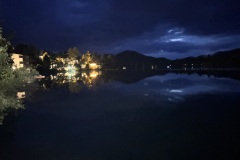
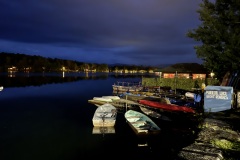
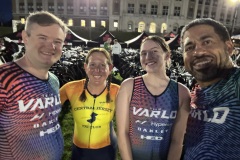
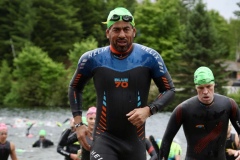
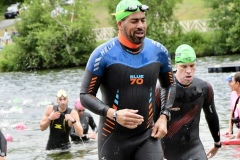
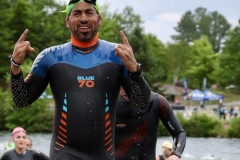
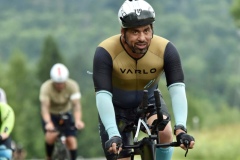
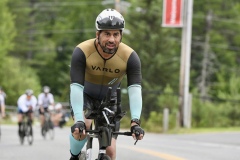
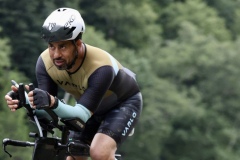
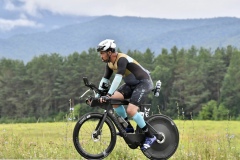
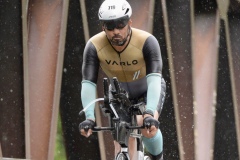
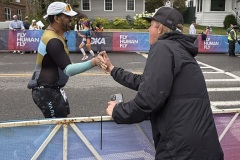
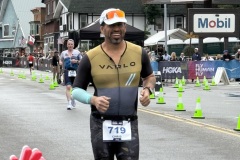
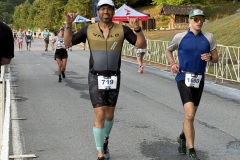
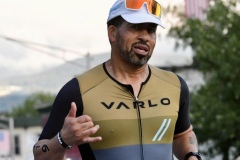
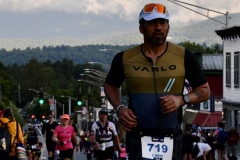




Great story Chris. I love the mantra of not letting fear make the decision. I don’t think you lost any battles. You took on a relentless foe and kicked it’s ass! Congratulations man, you are a WINNER!!!